Cost of Laying Turf
Last updated 23rd March, 2025
Wondering how much laying turf or a new lawn costs?
The average cost of laying new turf ranges from £155 to £850, depending on the size of the garden and the quality of the new turf.
This guide offers an in-depth look at turf laying prices, along with additional costs, how to lay turf, the best time to lay turf, and turf maintenance tips.
Want to find out more? Let's get to it!
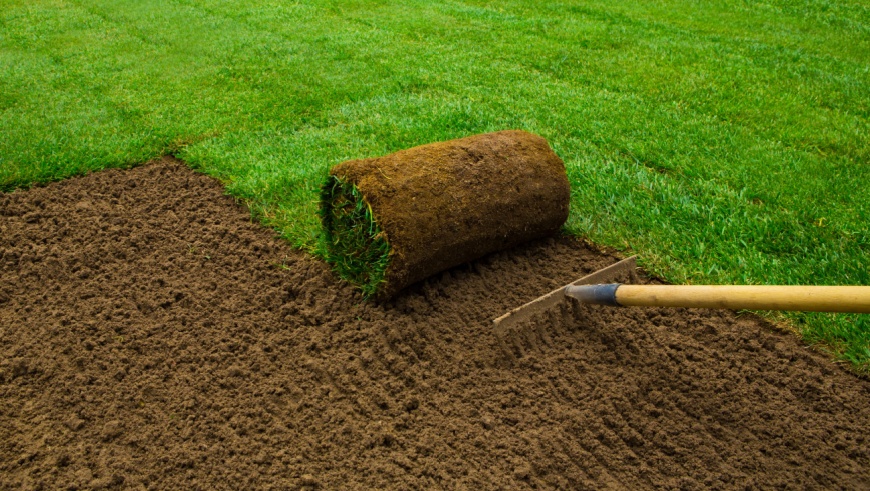
How Much to Turf a Garden?
The cost to lay garden turf is determined by various factors, including the material cost, as you can choose from budget, medium and premium turf options, which vary in price.
The higher the quality of the turf, the more you will pay. What can affect the overall cost of laying turf?
The overall turf laying cost will also depend on the size of the garden, as the larger the area the more turf will be required, which will, of course, increase the price. The estimated cost to supply, prepare and lay new garden turf is typically around £650 to £750 for a 50 square metre garden. However, other factors can significantly add to the cost.
What else affects the cost of laying turf?
You also need to consider any other costs that may be involved like garden maintenance and clearing. As an example, the average garden maintenance cost can be between £10 and £50 per hour, depending on how much work needs doing.
Accessibility and shape of your garden could also raise your labour costs.
Table of Contents
Resurfing Lawn Prices
Below are some average costs of laying garden turf:
| Garden Size | Turf Cost | Labour Cost |
|---|---|---|
| Extra Small (under 10m²) | £30 | £125 |
| Small (10 - 25m²) | £75 | £300 |
| Medium (25 - 75m²) | £150 | £500 |
| Large (75 - 100m²) | £250 | £600 |
Turf Installation Cost Breakdown Calculator
Individual costs for laying turf for a 50 square metre garden —
Total Cost: £700
Materials
£140
Tradesmen
£525
Waste Removal
£35
How Much Does Turf Installation Cost? (Labour Only)
Let's move on to the turf-laying labour costs and timeframes involved.
A gardener will usually charge around £150 per day to lay new turf. They typically work with a general labourer who charges around £100 per day.
How long does it take to lay turf?
The job on average will take around 2 to 3 days to complete depending on the size of the garden and any issues preparing the ground. To give you a better idea of the labour costs, below are some estimated costs of hiring a gardener to lay new grass turf.
Please note that these costs assume the garden is fairly level with no major weed growth or concrete.
Check out this complete construction statistics guide for information on the construction industry.
| Garden Size | Duration |
|---|---|
| Extra Small (under 10m²) | 4 - 8 hours |
| Small (10 - 25m²) | 1 - 2 days |
| Medium (25 - 75m²) | 2 days |
| Large (75 - 100m²) | 2 - 3 days |
Bear in mind that any ongoing labour costs won't be included in this.
So, for example, if you need support maintaining your turf, you'll need to factor in the cost of a gardener to your ongoing budget.
Turf Costs Per M²
Not sure which type of turf is best?
Here we look at the various turf options available to help you choose the right grass for your garden.
Budget Turf Cost
Budget lawn turf is a general-purpose turf that is suitable for most lawns and easy to maintain. However, it’s probably not suitable if you plan to do more than just look at your lawn, as it is not as durable as other options.
The average cost of budget turf is around £2 to £4 per square metre.
Hard-Wearing Turf Cost
Hard-wearing turf is constructed to endure tough use on football and rugby pitches. It contains 60% ryegrasses and is ideal for lawns subjected to heavy use.
Hard-wearing turf is typically priced at £5 to £7 per square metre.
Premium Turf Cost
Premium turfs offer a dense, deep green finish and are both hard-wearing and great to look at. They're also easy to maintain.
You should expect to pay around £7 to £10 per square metre.
Wildflower Turf Cost
If you’re looking for something a bit different from an ordinary lawn, you might want to consider wildflower turf, which will turn your garden into a beautiful meadow.
It is particularly good for shaded zones such as underneath trees and low-light spaces in your garden. Wildflower shade-tolerant turf is also appropriate for open areas with full sun and where additional plants will thrive.
However, to get your beautiful wildflower meadow, you will need to do a lot of extra planning and preparation, which will add to the cost of your project. Once laid; however, wildflower turf is low maintenance.
On average, you can expect to pay between £15 and £20 per square metre for wildflower turf.
How do you choose the right turf?
Before choosing turf, you should ask yourself the following questions:
- Do you want a hard-wearing or a first-rate decorative lawn?
- Will the lawn have to survive with children playing football and pets wandering on it?
- What kind of lawnmower will you use and how regularly do you plan to mow?
- Does the turf comply with the Turf Growers Association (TGA) standards?
What else do you need to consider?
Turf is normally supplied in either small rolls (600mm wide and 1.65m long) or big rolls which can vary in size and can be agreed in advance. The typical seed mixture used in turf for general garden use includes:
- 20-40% dwarf perennial ryegrass.
- 30-50% slender creeping red fescue.
- 10-25% chewings fescue.
- 10-30% smooth-stalked meadow-grass.
Additional Costs of Laying Turf
When laying turf, you may want to consider some additional jobs to enhance the look of your garden. For instance, if you have an uneven lawn full of weeds, this will need much more preparation work and levelling than a lawn in reasonable condition.
The quality of the existing topsoil makes a difference too. A garden full of deep-rooted invasive weeds is a nightmare for a landscape gardener and means a lot of extra preparation work.
This often involves strimming the weeds before rotavating and putting down some anti-weed mulch and then additional topsoil. This can take 2 to 5 days depending on the size of the garden and usually £150 per day for labour.
Should you need to buy topsoil, you can choose either 10mm or 20mm. It’s usually sold in large bags, with reasonably priced mid-range topsoil costing between £70 and £90.
Here's another thing!
Access is another important factor when it comes to pricing jobs, if you live in a property with restricted access to the garden or no parking nearby, many companies will charge extra to cover the additional time spent getting the tools and materials to the site.
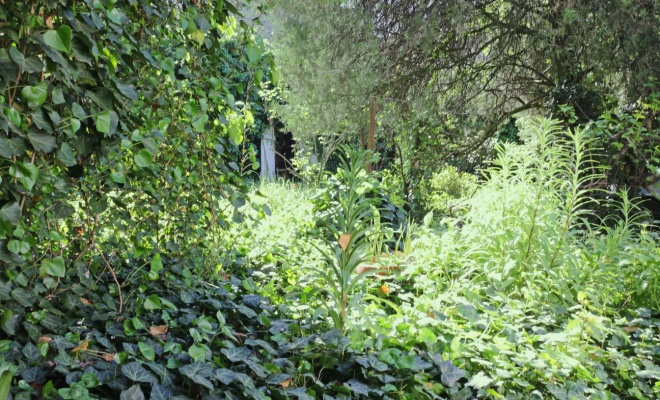
How to Lay Turf
On a budget?
If so, you may decide to save on labour costs by laying the turf yourself. DIY turf laying is fairly straightforward, provided you prepare properly and take note of the following step-by-step guide.
Step 1 - Choosing When to Lay Your Turf
You can actually lay turf at any time of the year – but certain conditions will offer the best chance that it will take and give you a healthy lawn. For example, you will want to avoid laying your turf when the ground is frozen or waterlogged.
Generally, turf is better laid in mid-autumn but can be placed any time from the middle of autumn to late winter as long as the soil isn’t too drenched or frosty. In spring and autumn, only a small amount of mowing is required to let newly laid turf rest and be left untouched for a few weeks.
Don’t lay turf from the middle of spring until the beginning of autumn, so you don’t need to water it repeatedly. Turf laid in spring normally requires more watering in dry periods in summer. Dry soil and mowing before the grass is completely rooted will strain turf and postpone rooting.
Step 2 - Turf Delivery and Storage
Turf is highly perishable, so you should check with your supplier that your turf will only have been lifted within 36 hours before delivery. If it’s spring or summer, this time should be decreased to guarantee turf is garden-fresh when it turns up.
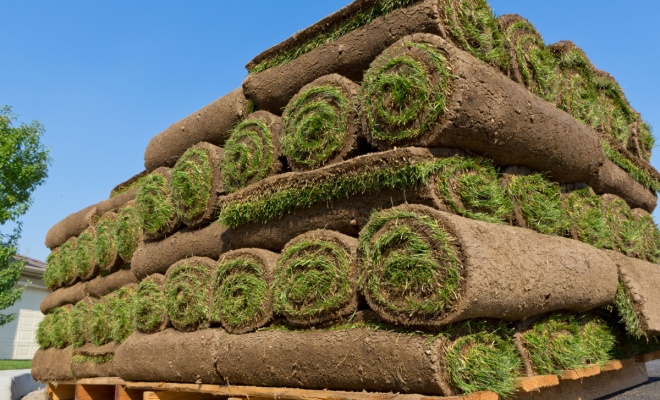
Always check any turf you have delivered. It should be green and not visibly affected by any pest or disease. The height of the sward (the green part of the turf) should not exceed 35mm. The soil layer underneath should be between 5 and 15mm deep.
Have your turf unloaded as near to where you’re laying it. It should be stacked on flat level ground in a shaded area, particularly if it is not to be laid on the same day.
Step 3 - Preparing the Ground
Careful preparation will give your new turf the best chance to settle and give you the lawn of your dreams.
If you're doing the lawn yourself, don’t be tempted to simply lay the new turf on top of your existing lawn to save time and money. You are likely to end up with brown, dying turf and the cost of relaying. New turf needs to be laid onto properly prepared soil if it is to establish and thrive.
Mark out the area you wish to turf and then make sure you thoroughly dig out any existing weeds. This will make life much easier and will prevent unwanted weeds from growing through the new turf.
Step 4 - Fertiliser
Once your turfing area is ready, you will need to spread pre-turfing fertiliser. This is an important factor in cultivating a healthy lawn. One 5kg bag will cost around £15 and will treat up to 100-150 square metres. We recommend an organic blend, like chicken manure fertiliser, which is both environmentally friendly and easy to spread.
Step 5 - Topsoil
Now you’re ready to lay your topsoil. Spread evenly, lightly cultivate and rake using a fine-tooth rake to a depth of at least 15cm ready to receive the turf roots. If the existing soil is poor quality or not deep enough, you’ll have to add more quality topsoil. To stop compaction don’t use wet soil.
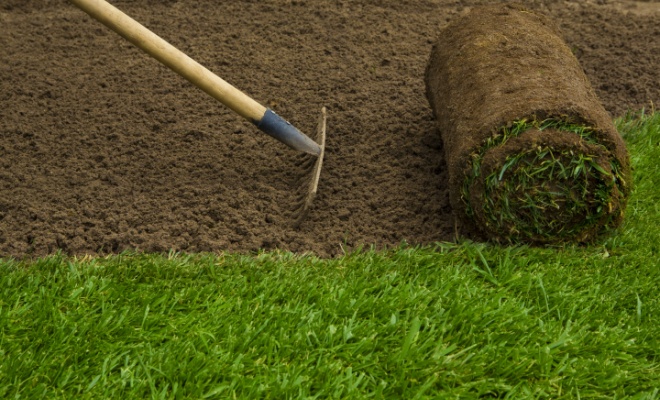
Remove all extraneous material, including stones larger than 35mm. Smaller stones can remain as they will help with consistency and irrigation. When you’re finished raking, the area you wish to turf should have a fine, even consistency.
Step 6 - Laying Your Turf
Begin laying the turf against a straight side of your marked-out area, joining each end as closely together as possible.
On each subsequent row, stagger the joints like brickwork, taking good care that there are no breaks. If you need to alter the position of the turf, always push it rather than pulling it to avoid stretching.
It’s always best to use wooden planks to avoid walking on newly-laid turf and potentially causing damage or leaving footprints. Remember, your turf is still very sensitive at this early stage in its life.
When laying, make sure the underside of each piece of turf is completely bonded with the topsoil. If necessary, press down on the turf through your planks to remove any air pocks that will prevent your turf from receiving the moisture it needs. Check when you’ve finished. If there are any gaps, plug these with topsoil and lightly compact.
Step 7 - Watering
You should water immediately after laying each row of turf. The first watering should confirm the soil is wet to a depth of 10cm. Keep the turf and the soil beneath it damp – you can inspect this by softly turning up a corner of the turf.
Use natural rainwater from a water butt if you have one. If not, tap water from the kitchen or bathroom is fine. Check the weather forecast – if it rains, you may not need to water at all depending on how much falls.

Water your turf in the early morning and early evening. However, avoid over-watering, and if your turf feels waterlogged, leave time to let the water seep through. Over-watering can lead to shallow root establishment, which will weaken the grass and can also create boggy conditions and promote diseases.
For the first month after laying your turf, it should never be allowed to dry out. After a month of regular watering, you can start to reduce the amount of watering, but always taking care that your turf remains moist.
Step 8 - The First Cut
When you mow your lawn for the first time ensure the mower blades are sharp and don’t cut it too short, as this strains the grass. Cut the grass as soon as the lawn has grown to about 5cm. Then mow as required until you can see the grass has stopped growing.
Once your new lawn is founded, don’t panic if it looks brown and dry. Going brown is its survival procedure. When water is in short supply, grass retorts by closing down. The brown colour simply shows it has stopped growing. Grass is remarkably resilient and most lawns will recover completely when the rain finally arrives.
Step 9 - Using Your New Lawn
It’s always a temptation to start walking or playing on your new lawn as soon as it’s been laid. However, it needs time to settle and bond with the undersoil. A period of 2 to 3 weeks should be long enough in the summer, perhaps a bit longer in the winter. The rule of thumb is that if you leave an impression when walking it's too soon.
Garden Turf Diseases
Did you know that newly-cut turf is susceptible to disease?
To prevent garden turf diseases, you need to monitor your grass closely and look out for the tell-tale signs.
Common turf diseases include:
Rust Disease
This is a common turf disease caused by fungi. Rust disease may produce vast numbers of air-borne spores.
Typical symptoms of rust disease include:
- Patches of yellow grass.
- Large numbers of tiny, spore-producing pustules, usually orange, but often black in autumn.
How do you prevent rust disease?
To avoid rust diseases you should consider the following tips:
- Feed your lawn frequently throughout the growing season to preserve vitality.
- Keep away from high nitrogen fertilisers in autumn, as the subsequent growth may be more vulnerable to attack from rust disease and others.
- Mow regularly to decrease the number of infected grass stalks and improve air circulation by pruning overhanging trees and shrubs.
Fusarium Patch (Snow Mould)
This disease is triggered by the fungus microdochium nivale. It’s one of the most destructive diseases of turf and can be problematic to control.
It mostly occurs in autumn, winter and the beginning of spring, but bouts can strike at any time of the year. It is sometimes very noticeable after thaws of snow, hence its name.
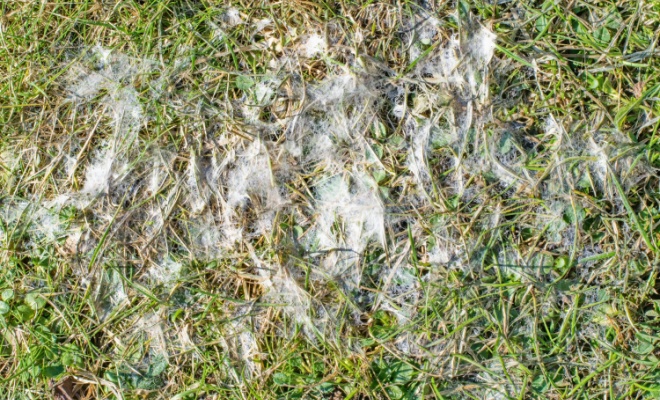
Fusarium Patch symptoms include:
- Small patches of yellowish, dying grass that later turn brown.
- Patches will increase in size and can even reach 30cm (or larger) in diameter, frequently joining together so that great areas can be disturbed.
- During wet weather, a white or pink cottony fungal growth might be spotted, mainly around the edges of the patch.
How do you treat snow mould?
The best way to treat snow mould is by enhancing overall airflow over the lawn by clipping back hanging trees or bushes. You should also get rid of heavy dew in the morning using a switch or bamboo cane.
Try to avoid high doses of nitrogen fertiliser in summer or autumn. Instead, use an autumn lawn feed in its place.
The only recommended chemical treatment for this disease is trifloxystrobin (Provanto Lawn Disease Control). It can be utilised all year round excluding droughts or when the lawn is icy. It shouldn’t be put on more than twice a year and is best used in conjunction with the control methods mentioned above.
Red Threat
Red threat occurs during wet summers and autumn on dead grass. It’s caused by Laetisaria fuciformis, a fungus.
Read Threat symptoms include:
- Patches of infected grass with a reddish tint, afterwards turning light brown or bleached. They normally differ in size from 7.5cm to 25cm in diameter but can be a lot bigger.
- Two types of fungal growth may be seen on the patches, particularly under wet or humid conditions. The first takes the form of small, pink, cottony flocks, the second are pinkish-red, thread-like structures, 1-2mm (less than ¼in) in length.
What's the best treatment for Red Threat?
The best treatment is nitrogen in the form of sulphate of ammonia applied 15g per square metre.
Make sure you don't use after August to evade the soft growth which can also cause snow mould. Using a lawn rake to eliminate thatch and increase ventilation.
Getting rid of grass waste will also decrease the quantity of fungus existing in the lawn.
Toadstools/Mushrooms
Toadstools and mushrooms are common in recently laid turf. They will not damage your lawn and can be removed by simply mowing daily until no more mushrooms are coming through.
Alternatively, you can break the stems of the mushrooms by brushing which will dry them out and they will disappear.

Turf Maintenance by Season
Below is a seasonal guide for maintaining your lawn at all times of the year.
Spring
- Don’t get caught out with early growth! Keep an eye out for when you need to mow.
- Make sure the blades on your mower are sharp.
- Why not give your turf some spring fertiliser?
- You might need to scarify to get rid of moss and thatch.
- If your lawn has yellow or bare patches you can apply a fertiliser to aid growth.
Summer
- Keep on top of lawn mowing.
- Compost your grass clipping.
- Mature lawns don’t need watering.
- Fertilising is important, certainly if your grass needs it.
Autumn
- Clear leaves to avoid a patchy lawn.
- Watch out for brown patches - this could be an indication of a fungal disease.
- Don’t mow if your lawn is waterlogged.
- Apply fertiliser to ensure your lawn has enough nutrients.
Winter
- Winter is the time to take a break.
- You could revisit and detail your turf edges.
- To prevent damage to your lawn, let snow clear naturally.
If you need support with maintaining your turf, the cost of lawn care starts from £13 per quarter for fertiliser alone.
More complex or frequent treatments will cost more. For example, the lawn treatment cost for topdressing can range from £80 to £180. If you combine this with other lawn care tasks, the costs could mount up.
Alternatives to Turf
Looking for a low-maintenance alternative to turf?
Turf requires a significant amount of maintenance, so if you do not have the time, you may prefer other options including alternative grass choices or decking.
For something completely different, you might even decide to install a pond in your garden instead of laying turf. The typical cost to install a garden pond ranges from £500 to £5,000.
Artificial Grass
It’s becoming more common that people are selecting artificial turf over real grass because they involve minimum maintenance.
They also look great in a smaller area and for people who find garden upkeep tough or costly.
It is also ideal if you have young children or animals, as it’s difficult to destroy or mess up.
If the artificial lawn is laid and maintained correctly, it can have a lifespan of 7-10 years.
What's the cost of artificial grass?
There are various types of artificial grass offered, which differ in cost.
Generally, the cost of installing artificial grass is around £600 to £4,500. This price is based on a 10-square-metre lawn, which is slightly smaller than the average UK lawn.
To give you a better idea of artificial grass costs, take a look at the below table:
| Artificial Grass (per sqm) | Description | Avg. Cost |
|---|---|---|
| Elite Lawn | Mixed pile, very realistic, Variety of colours available. | £26 |
| Landscape Lawn | A two-tone pile, natural and realistic. | £23 |
| Basic Lawn | A shorter pile with a three-tone colour variety. | £16 |
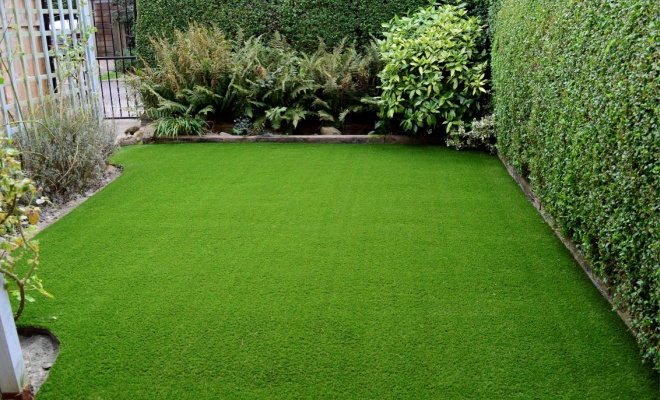
Grass Seed
Using grass seed is the more traditional method for laying a lawn.
So should I choose seed or turf?
Below are some of the key advantages and disadvantages of seed:
Advantages
- ✔ Seed is much cheaper than turf.
- ✔ Seed takes up little space so it can be stored away till the weather is better and the ground is ready.
- ✔ It’s not heavy – you don’t have to be burly, active or agile to spread grass seed.
- ✔ Not messy.
- ✔ Any leftover seed can be stored and used for lawn repairs at a later date.
Disadvantages
- ✖ Seed will take longer than turf. It can take six to twelve months to create a fully-grown lawn from seed.
- ✖ Choosing the right seed mix without any knowledge can be confusing.
- ✖ Growth is typically not level, and in cold temperatures, it can be slower.
- ✖ Grass seed has to be protected against birds and cats.
- ✖ You’ll notice that all types of weeds will sprout next to your grass – be ready to remove them.
Patio
An alternative to turf or other lawn installations is a patio.
One of the main benefits of a patio in comparison to turf is that it is easier to maintain. Whereas turf needs plenty of attention, especially at the beginning, a patio can be laid and enjoyed quickly.
The cost of laying a patio will generally be more than installing turf but the ongoing garden maintenance costs may be lower. You'll typically be looking at between £800 and £1,500 to lay a new patio.
Advantages
- ✔ Easier to maintain.
- ✔ Plenty of materials to choose from.
- ✔ Immediately attractive.
- ✔ Customisable with seasonal furniture.
Disadvantages
- ✖ Higher upfront costs.
- ✖ Less greenery in the garden compared to turf.
- ✖ Drainage can be an issue if not installed correctly.
- ✖ Regular weeding will still be needed.
Timber Decking
Garden decking is another alternative to grass, with timber decking one of the most popular options.
A timber deck suits many property styles and there are options available for different budgets.
However, the cost of timber garden decking installation is more than turf or a patio, with the most budget-friendly option costing around £900 to £1,400.
Advantages
- ✔ Timber is an environmentally friendly option.
- ✔ Installation can be customised to your tastes.
- ✔ Attractive to look at.
- ✔ Durable material.
Disadvantages
- ✖ Costs more upfront.
- ✖ Will require care to ensure its longevity.
- ✖ Budget options can need more maintenance.
- ✖ Can fade through exposure to the sun.
- ✖ Planning permission may be needed for a raised deck.
Composite Decking
A typical alternative to traditional wooden decking is composite decking.
As a composite of wood and plastic, this type of decking generally needs less maintenance than wooden decking while still offering a similar aesthetic.
On average, composite decking prices are around £1,600. This varies depending on the size of the area to be decked and how much work is involved.
Advantages
- ✔ Requires very little maintenance.
- ✔ Resistant to UV rays.
- ✔ Often comes with a long guarantee.
- ✔ Looks good when installed.
Disadvantages
- ✖ More expensive than timber decking.
- ✖ Not as environmentally friendly as timber.
- ✖ Can't be stained or sanded once down.
- ✖ Can react to some chemicals.
Turf Removal Cost
Why would you need to remove turf?
You may want to remove turf for flower beds, to be replaced with fake grass, or you need to replace your turf with healthier turf.
If you hire a gardener to complete this, expect to pay £300 to £400 in labour on average, and the overall cost of garden waste removal may include extra expenses for dealing with trees or stumps.
For waste disposal, you may want to consider hiring a skip. The average skip hire costs range from £140 to £300.
To DIY, you’ll need a spade to cut the turf into squares and remove it. It’s better to do this with damp soil rather than dry, hard soil.
To remove turf, you don’t have to dig very far down; grass tends to stay in the top layer of the soil.










